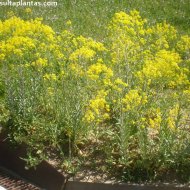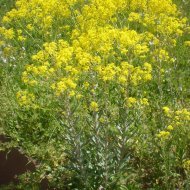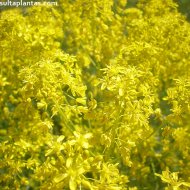Care of the plant Isatis tinctoria or Woad |
|
The genus Isatis, family Brassicaceae, includes about 40 species of herbaceous plants native to central Asia and the Mediterranean basin. Some species are: Isatis tinctoria, Isatis glauca, Isatis boissieriana, Isatis iberica, Isatis violascens. Common names: Woad, Dyer's woad, Asp of Jerusalem, Glastum. This species is native to central Asia, Siberia and the Caucasus. They are biennial herbaceous plants that reach 1 meter (39.37") in height. They have basal leaves arranged in a rosette and other smaller lanceolate leaves on the stems. The showy inflorescences full of yellow flowers appear at the end of the stems. They bloom in spring and early summer. Woad is used in wild gardens, rockeries, slopes and borders. In the past it was used as a dye, as a natural insecticide and as a medicinal plant. Isatis tinctoria prefers a full sun exposure. It resists frost quite well up to -15 ºC (5 ºF). Asp of Jerusalem grows in any type of soil but prefers well-drained soils whether they are poor, sandy or stony. Water regularly so that the substrate is always slightly damp; Glastum resists a few days of drought. Fertilize with a little organic matter at the time of planting. Woad does not need pruning. Isatis tinctoria is a plant resistant to the usual pests and diseases. Dyer's woad is propagated from seeds sown in late winter, early spring, or fall. |
Images of the plant Isatis tinctoria or Woad |
Find plants
Isatis tinctoria or Woad | Care and Growing
© 2025 FavThemes


